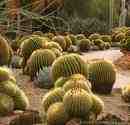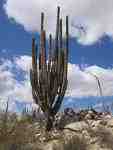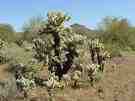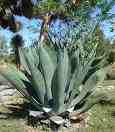A Cardon Cactus: Fruit and Facts
A few of Mexico's thorny pals
Click thumbnail to view full-size






Cacti have a multitude of uses.
Cactus: The Desert Lifesaver
Apart from a handful of exceptions, cacti are native to the Western Hemisphere. The plants are probably more associated with Mexico and the South West USA than any other region: Mexico alone has more than 1000 species, making a visit to the deserts there an exotic experience never forgotten (especially if the Jumping Cholla cactus also visits you!).
Evolution has equipped these singular plants to survive where few other plant species can, and, in turn, they are vital for the survival of many species of birds, reptiles, insects and small mammals. The cactus was once an important factor in man’s survival and well- being in the drier parts of the country.
Cactus share several traits: They are always perennial plants with fleshy stems and outer flesh protected by a hard outer bark, itself covered in spines to prevent predation. Anyone who has lived around cacti knows these spines, or thorns, are no joke; some worse than others (like the abovementioned jumping cholla which does indeed seem to “jump” as it sinks its barbed spines into a juicy, fat Gringo thigh…blood pours as they are wrenched out to tuneful cries and numbing expletives!). Others have even taken the lives of riders being thrown into them - especially the agave - the long spines piercing the heart.
Cacti are all designed to store water during infrequent wet seasons and hang on to it, sometimes for years, until the next rain cloud arrives. They use photosynthesis as do all green plants, but the cactus employs this process at night so their precious water won’t evaporate through the stomata. They add sunlight during the day to the carbon dioxide already in solution. Although cacti present a rugged construction, 90% of their bulk consists of water. Like concertinas, many have ribs which allow them to balloon-out and deflate, depending on precipitation. A cactus completely deprived of rainfall may take 10 years or so to loose all its stored water, which makes them such an ideal garden plant in dry area like Arizona and parts of California. We see them all over Britain these days, although they don’t really take to our climes (what does?) and a hard frost will kill them immediately: they are happier in the warmer USA (who isn’t?). They are all fine indoors, of course.
The nasty spines are actually modified leaves; apart from the prick, many are impregnated with substances like pectin, which is why they smart so much. Others tend to break-off under the skin and have to be dug out…taking it out on an offending cholla by kicking it might result in surgery! Many of the fruits have fine hairs which are quite dangerous to ingest. Enterprising ranchers in Mexico forgo barbed wire and plant cactus fences which soon mature and keep stock in or out very effectively.
One cactus we are all familiar with is the Barrel Cactus, of which there are about 12 species, some as tiny as a golf ball, others taller and much wider than a sumo wrestler…about like MP John Prescott but far better looking; although substantial, like most cactus, they only have weak and shallow root systems, making them a snip to dig up and transport: careful, even some roots have spikes, mama cactus didn’t breed no fool! Barrel, or biznaga, were the fellows early Mexicans burned on the fire and chopped up as stock feed in hard times (nearly always in the Mexican desert region). Many parched travelers survived the desert by chopping into a barrel and sucking the saturated, sweet flesh (Careful, some are mildly toxic).
Many cactus also have edible fruit and flowers, some are delicious and thirst quenching (the sweet and sour pitaya has fruit sold along the roads in season). Cactus were once used for a score of other tasks: the spines were used as needles, awls and arrow tips; the barrels make ideal cook pots once the outside has been scooped out. (hot stones and leaves were put in with the meat to be cooked).
Some cactus grow to considerable heights and become the “trees” of the desert. The Saguero and the Cardon cactus are the two largest. Each of the huge boles and crowns of the hundreds-of-years-old mature plants support whole colonies of insects and birds which use them to nest. They have been cut for centuries to use in construction, although their wood is hardly load-bearing - something more like balsa.
The sweet fruit from the Pitaya (Organ Pipe Cactus fruit) was consumed by the Pericue and other Baja Indian races in an orgy of greed during the season it was ripe until their tummies were completely distended. Then they would then defecate behind a convenient large bush or cactus, which is why many of the convoluted pitaya plants are situated behind mesquite growth or other large cactus today. They also had ceremonies involving separating the seeds of the fruit after it had passed through the consumer; grinding it down and making a meal suitable to add to local dished like pozole! Not a good time for the tourist to join them at the table.
Early settlers in Baja California found many other uses for the huge Cardon cactus (not to be mistaken for the Saguero, not found in Baja). The harder parts of all dried (dead) cactus makes extremely hot cooking fires. As the local trees were stripped-out, substitutes were found in mature cactus for fences, rafters, fishing poles and much more.
If you decide to plant cactus in pots, don’t over-water them. Use less volume than with house plants or the leaves will blacken and die. They can go outside in the summer in Europe, but will have to be well wrapped or put indoors or in greenhouse and sheds in winter (OK from April to October outside normally). Don’t let quick growing cactus become crowded in pots; remove branches and arms, etc., which will grow themselves when replanted.
You are not supposed to remove cactus from Mexico or US desert regions, but no one would mind if you took pieces to replant I’m sure. Customs agents will enjoy discovering a jumping cholla in your baggage!










